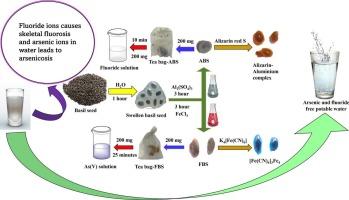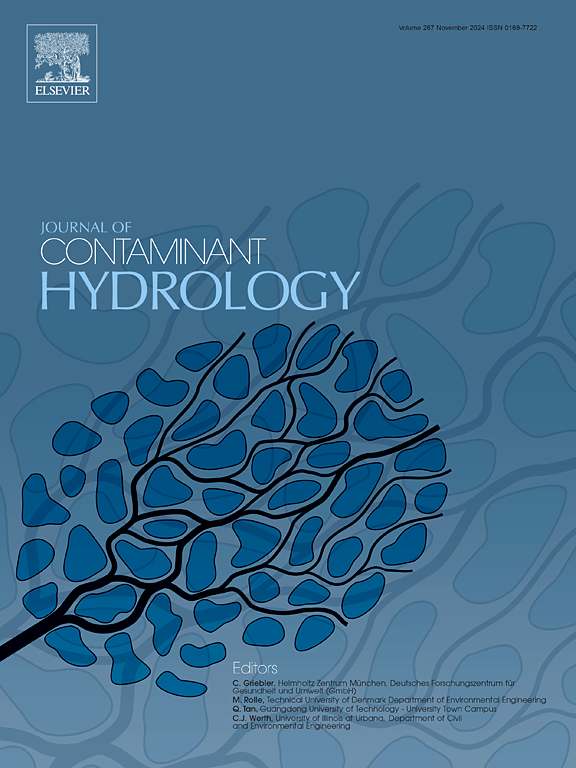工程罗勒籽水凝胶对地下水阴离子污染物的生态吸附。
IF 4.4
3区 环境科学与生态学
Q2 ENVIRONMENTAL SCIENCES
引用次数: 0
摘要
本研究试图通过利用罗勒种子(BS)作为水净化的天然手段,解决地下水中常见污染物砷和氟离子的存在。在本研究中,分别用铁离子(FBS)和铝离子(ABS)对BS进行改性,以促进对砷和氟离子的吸附去除。通过批量吸附法和茶包浸渍法进行了吸附实验。利用体视显微镜、FE-SEM和TGA分析对改性的生物吸附剂进行了表征,以确定其形态和热稳定性。本研究旨在阐明砷和氟离子浓度、平衡时间、温度变化和pH水平对吸附现象的影响。吸附等温线符合Langmuir吸附模型,动力学符合拟二级反应模型。值得注意的是,观察到污染物的快速去除,氟离子在10分钟内的最大吸附量为20 mg/g,砷离子在20分钟内的最大吸附量为3.03 mg/g。结果表明,化学吸附机制主要控制污染物的去除。这些发现强调了当地罗勒种子作为一种有前途的低成本生物材料的功效,可以有效地从饮用水中去除砷和氟离子,并具有实时应用的潜力。本文章由计算机程序翻译,如有差异,请以英文原文为准。

Engineered basil seed hydrogel for eco-conscious adsorption of anionic contaminants in groundwater
This investigation endeavours to address the presence of arsenic and fluoride ions, common contaminants in groundwater, by utilizing basil seeds (BS) derived from Ocimum basilicum L. as a natural means for water purification. In this research, BS were modified with ferric ions (FBS) and aluminium ions (ABS) to facilitate the adsorptive removal of arsenic and fluoride ions, respectively. Adsorption experiments were conducted through batch adsorption and the teabag dip methods. The modified biosorbents were characterized using a stereomicroscope, FE-SEM, and TGA analyses to ascertain their morphology and thermal stability. The study aimed to elucidate the impact of arsenic and fluoride ion concentration, equilibration time, temperature variations, and pH levels on adsorption phenomena. The adsorption isotherm data conformed well to the Langmuir adsorption model, while kinetics adhered to the pseudo-second-order reaction model. Notably, rapid removal of contaminants was observed, with a maximum adsorption capacity of 20 mg/g within 10 min for fluoride ions and 3.03 mg/g within 20 min for arsenic ions. The results indicate that chemisorption mechanisms primarily govern the removal of contaminants. These findings highlight the efficacy of locally sourced basil seeds as a promising low-cost biomaterial for the efficient removal of arsenic and fluoride ions from drinking water, with demonstrated potential for real-time application.
求助全文
通过发布文献求助,成功后即可免费获取论文全文。
去求助
来源期刊

Journal of contaminant hydrology
环境科学-地球科学综合
CiteScore
6.80
自引率
2.80%
发文量
129
审稿时长
68 days
期刊介绍:
The Journal of Contaminant Hydrology is an international journal publishing scientific articles pertaining to the contamination of subsurface water resources. Emphasis is placed on investigations of the physical, chemical, and biological processes influencing the behavior and fate of organic and inorganic contaminants in the unsaturated (vadose) and saturated (groundwater) zones, as well as at groundwater-surface water interfaces. The ecological impacts of contaminants transported both from and to aquifers are of interest. Articles on contamination of surface water only, without a link to groundwater, are out of the scope. Broad latitude is allowed in identifying contaminants of interest, and include legacy and emerging pollutants, nutrients, nanoparticles, pathogenic microorganisms (e.g., bacteria, viruses, protozoa), microplastics, and various constituents associated with energy production (e.g., methane, carbon dioxide, hydrogen sulfide).
The journal''s scope embraces a wide range of topics including: experimental investigations of contaminant sorption, diffusion, transformation, volatilization and transport in the surface and subsurface; characterization of soil and aquifer properties only as they influence contaminant behavior; development and testing of mathematical models of contaminant behaviour; innovative techniques for restoration of contaminated sites; development of new tools or techniques for monitoring the extent of soil and groundwater contamination; transformation of contaminants in the hyporheic zone; effects of contaminants traversing the hyporheic zone on surface water and groundwater ecosystems; subsurface carbon sequestration and/or turnover; and migration of fluids associated with energy production into groundwater.
 求助内容:
求助内容: 应助结果提醒方式:
应助结果提醒方式:


